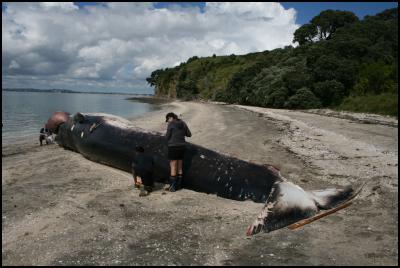Whale death in Hauraki Gulf highlights urgent need
Whale death in Hauraki Gulf
highlights urgent need to address ship strike
problem
A necropsy on a Bryde’s whale
found dead on Motuihe Island has confirmed that the whale
was hit by a vessel highlighting the urgent need to address
the ship strike problem to save the critically endangered
population of Bryde’s whales in the Hauraki Gulf.

Photo by
DOC
NewZealand is one of the few places in theworld
with a resident population of Bryde’s whale.The New
Zealand population of Bryde’s whales lives primarily in
the Hauraki Gulf and is listed as critically endangered by
the Department of Conservation (DOC).This is because its
small and reliant for its survival on one location. There
are less than 200 Bryde’s whales living in the gulf.
The dead Bryde’s whale was a female measuring 14.5 metres long. It was found on rocks near Wharf Bayon Motuihe on Sunday (November 11).The Department of Conservation (DOC) towed the whale to Calypso Bayon Motuihe, on Monday (November12).
The necropsy was completed yesterday (Wednesday November 14) and the whale was buried at Calypso Bayafter being blessed by Ngai Tai representatives. Calypso Bay is a suitable site for the necropsy and burial as it’s rarely used by visitors to Motuihe and has no archaeological sites.
“The necropsy has confirmed the Bryde’s
whale was alive when it was struck by a vessel and died as a
result of the injuries it received,” says DOC Auckland
Area biodiversity manager Phil Brown.
“Ship strike
poses the greatest threat to Bryde’s whales in the Hauraki
Gulf Marine Park. This latest death highlights the urgent
need to take action to address this problem,” says Phil
Brown.
In the last 16 years there have been 42 confirmed deaths of Bryde’s whales in the Hauraki Gulf. Eighteen of these dead whales were examined and 16 are most likely to have died as the result of being struck by a vessel.
DOC is working with a wide number of organisations and agenciesto address theship strike issue. The Environmental Defence Society ,the Hauraki Gulf Forum and the University of Auckland have convened two workshops attended byshipping interests, iwi, DOC and other government agencies to develop a plan of action.
As a result of the workshops DOC is working with shipping representatives and Auckland University marine mammal biologist, Dr Rochelle Constantine to develop practical steps to reduce the risk of ship strike.
The shipping representatives have
agreed to implement a number of measures. These
include:
• Slowing their ships down in the Hauraki Gulf
when schedules permit
• Establishing shipping lanes to
reduce the area of the gulf in which ships travel. These
lanes will be able to be moved away from areas where whales
are sighted. Crew watching for whales while their ships move
through the gulf during the day
• Establishing a
Hauraki Gulf Large Whale Warning System. This will involve
commercial whale and dolphin watching operators, and other
boats in the gulf, reporting whale sightings to Ports of
Auckland who relay the sightings to all shipping in the
gulf.
• The shipping industry has agreed to contribute
funding for research focusing primarily on ways of reducing
ship strike.
•
Hauraki Gulf Forum Chairman John
Tregidga says the ship strike workshops highlighted the
critical importance of ship speed to the survival of
whales.
“A few large ships travel through the Hauraki Gulf at more than 20 knots. The average speed for large ships in the gulf is 14.2knots. Scientists have estimated that if this speed was reduced to 10 knots, the Bryde’s whale would have a 75% chance of surviving a strike,” says John Tregidga.
“I would strongly encourage the industry to establish 10 knots as a code of best practice for the Hauraki Gulf,” said John Tregidga
“Itis good to see shipping interests actively engaged in the issue,” says Environmental Defence Society Policy Director Raewyn Peart.
“But this latest incident highlights the urgent need for shipping companies to reduce the speed of their vessels before any more whales are killed.”
“Research conducted last summer showed that the whales are widely dispersed and shallow divers. They are particularly vulnerable at night when the animals float close to the surface.”
“Ship speed is the critical factor in their decline and must be the priority for industry and legislative responses,” concluded Raewyn Peart.


 Gordon Campbell: On Abortion’s Role In The US Election
Gordon Campbell: On Abortion’s Role In The US Election NZ Defence Force: NZDF Honours Last Māori Battalion Warrior, Sir Robert Nairn Gillies KNZM
NZ Defence Force: NZDF Honours Last Māori Battalion Warrior, Sir Robert Nairn Gillies KNZM The Treasury: Interim Financial Statements Of The NZ Govt For The Three Months Ended 30 September 2024
The Treasury: Interim Financial Statements Of The NZ Govt For The Three Months Ended 30 September 2024 NZ Labour Party: Labour, Greens And Te Pāti Māori Call On The Prime Minister To Block The Treaty Principles Bill
NZ Labour Party: Labour, Greens And Te Pāti Māori Call On The Prime Minister To Block The Treaty Principles Bill NZ Taxpayers' Union: Has Simon Watts Forgotten Who The Minister Is?
NZ Taxpayers' Union: Has Simon Watts Forgotten Who The Minister Is? Department of Conservation: Priority Conservation Projects Open For Donations
Department of Conservation: Priority Conservation Projects Open For Donations NZ Labour Party: Winston Peters Must Apologise
NZ Labour Party: Winston Peters Must Apologise


